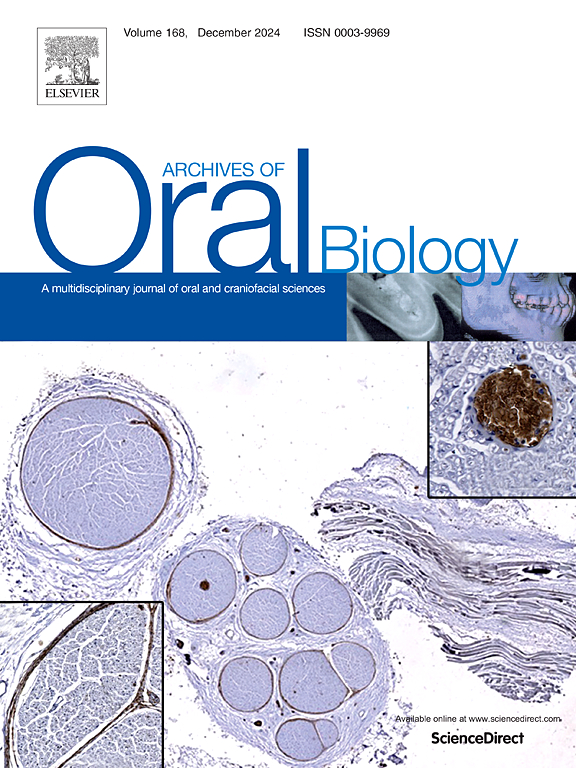Association between electronic nicotine delivery systems and dental caries: A systematic review with meta-analysis
IF 2.1
4区 医学
Q2 DENTISTRY, ORAL SURGERY & MEDICINE
引用次数: 0
Abstract
Objective
To explore the association between the electronic nicotine-delivery systems (ENDS) use and dental caries in adolescents and adults.
Material and methods
Two researchers independently conducted the search across six databases, study selection, data extraction, and assessment of risk of bias and certainty of evidence. Included studies involved participants ≥ 16 years old, assessed ENDS use, and employed clinical and/or radiographic methods for caries diagnosis. Risk of bias was evaluated using the Joanna Briggs Institute Checklist and the Newcastle–Ottawa Scale. A meta-analysis was performed to calculate the mean difference (MD) in caries severity between ENDS users and non-users. The GRADE approach was used to assess the certainty of the evidence.
Results
Of the 559 eligible studies, four were included (three cross-sectional and one was a prospective cohort). Three studies identified a potential association between the ENDS use and either the experience or risk of dental caries, as well as the prevalence of untreated teeth. Three studies were classified as having a high risk of bias. The quantitative analysis of the pooled effects (2 studies) showed no significant MD between the history of dental caries among those who did or did not use ENDS (MD: 0.72, 95 % confidence interval: −1.70–3.15).
Conclusion
It was showed a potential association between ENDS use and increased severity and risk of dental caries in both population groups. However, quantitative analysis showed disease severity is not associated with the use of these devices among adults. The certainty of evidence for qualitative and quantitative analyses was very low.
电子尼古丁传递系统与龋齿之间的关系:一项荟萃分析的系统综述
目的探讨青少年和成人使用电子尼古丁传递系统(ENDS)与龋病的关系。材料和方法两名研究人员独立进行了六个数据库的检索、研究选择、数据提取、偏倚风险评估和证据确定性评估。纳入的研究涉及≥ 16岁的参与者,评估ENDS的使用,并采用临床和/或放射学方法进行龋齿诊断。偏倚风险采用乔安娜布里格斯研究所检查表和纽卡斯尔渥太华量表进行评估。进行荟萃分析以计算ENDS使用者和非使用者之间龋齿严重程度的平均差异(MD)。GRADE方法用于评估证据的确定性。结果在559项符合条件的研究中,纳入了4项(3项是横断面研究,1项是前瞻性队列研究)。三项研究确定了终端使用与龋齿经历或风险以及未经治疗的牙齿患病率之间的潜在关联。三项研究被归类为具有高偏倚风险。综合效应(2项研究)的定量分析显示,使用ENDS或未使用ENDS的龋齿史之间没有显著的MD (MD: 0.72, 95 %置信区间:−1.70-3.15)。结论在两组人群中,ENDS的使用与龋病严重程度和风险增加之间存在潜在关联。然而,定量分析显示,在成年人中,疾病严重程度与这些装置的使用无关。定性和定量分析证据的确定性非常低。
本文章由计算机程序翻译,如有差异,请以英文原文为准。
求助全文
约1分钟内获得全文
求助全文
来源期刊

Archives of oral biology
医学-牙科与口腔外科
CiteScore
5.10
自引率
3.30%
发文量
177
审稿时长
26 days
期刊介绍:
Archives of Oral Biology is an international journal which aims to publish papers of the highest scientific quality in the oral and craniofacial sciences. The journal is particularly interested in research which advances knowledge in the mechanisms of craniofacial development and disease, including:
Cell and molecular biology
Molecular genetics
Immunology
Pathogenesis
Cellular microbiology
Embryology
Syndromology
Forensic dentistry
 求助内容:
求助内容: 应助结果提醒方式:
应助结果提醒方式:


